BYP 1984-1999
by Darren Scales (originally published in 1999)
It was Christmas 1984 when Mark and I first ventured into the world of media. The film “Ghostbusters” had been released during the seasonal period, taking the country by storm, and the final series of “The Young Ones” had just achieved national acclaim. It was these and similar Television programmes that inspired our production “Radio Kiddo”. This was an audio programme, consisting mainly of action and comedy spoofs, which lasted 45 minutes (one side of a C-90 tape). Little did we know that this first experiment in media would grow and give rise to the Backyard Productions we see today. Next followed “Radio Kiddo 2”, another audio production that unfortunately has since been lost.
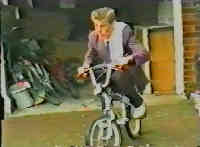 Soon we would move into the world of video. Although home video cameras were too expensive for us, our mother hired one for a weekend. Our first opportunity to make a film had arrived – and we did – “Blockbusters”. The filming was poor and the acting no better, but the attraction of film production was growing.
Soon we would move into the world of video. Although home video cameras were too expensive for us, our mother hired one for a weekend. Our first opportunity to make a film had arrived – and we did – “Blockbusters”. The filming was poor and the acting no better, but the attraction of film production was growing.
In 1993 camcorder prices were low enough for our family to be able to buy one. From then on, Mark, a local friend Edwin Hollingsbee, and I began to produce a host of short sketches including “Premium Bond Secret Agent” and “Home and Awaybours”. We were on our way to producing our first feature length film.
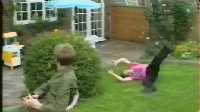 Steven Spielberg then released the movie “Jurassic Park”, a monster box office smash with special effects like none had seen before. Soon after this, Mark, Edwin and myself were in our ‘office’ (Mum’s kitchen) discussing whether we were ready to make our first film. After considerable deliberation, it was agreed that our first major project would be a Jurassic Park spoof. This would consist of a number of sketches, which would collectively be called “Geriatric Park.” This was also the pivotal moment when the company was formally named Backyard Productions (BYP).
Steven Spielberg then released the movie “Jurassic Park”, a monster box office smash with special effects like none had seen before. Soon after this, Mark, Edwin and myself were in our ‘office’ (Mum’s kitchen) discussing whether we were ready to make our first film. After considerable deliberation, it was agreed that our first major project would be a Jurassic Park spoof. This would consist of a number of sketches, which would collectively be called “Geriatric Park.” This was also the pivotal moment when the company was formally named Backyard Productions (BYP).
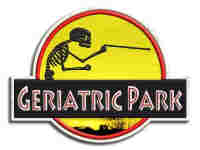 Work began on Geriatric Park with Edwin playing Alan Grunt, with Mark in the role of his fiancée, Ellie Phant. Another friend, Aaron Spain was to play the delightful John Hammock. The first two scenes were filmed and edited. The process was long and arduous, but there was another problem – we were very short of other cast members and crew and soon realised that without additional help, we would not be able to produce our film. Geriatric Park was put on hold for a few months, until I met Jason Bennett. He introduced me to his friends, with whom I hesitantly brought up the subject of our film. They were extremely interested and I showed them the two scenes we had already produced. We had never shown our work to anyone outside our small group before, and were nervous about how our work would be received. After many excuses about how it hadn’t turned out quite as we’d wanted, Mark pressed play and they watched…
Work began on Geriatric Park with Edwin playing Alan Grunt, with Mark in the role of his fiancée, Ellie Phant. Another friend, Aaron Spain was to play the delightful John Hammock. The first two scenes were filmed and edited. The process was long and arduous, but there was another problem – we were very short of other cast members and crew and soon realised that without additional help, we would not be able to produce our film. Geriatric Park was put on hold for a few months, until I met Jason Bennett. He introduced me to his friends, with whom I hesitantly brought up the subject of our film. They were extremely interested and I showed them the two scenes we had already produced. We had never shown our work to anyone outside our small group before, and were nervous about how our work would be received. After many excuses about how it hadn’t turned out quite as we’d wanted, Mark pressed play and they watched…
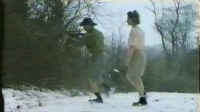 To our delight, they all wanted in on the project. We soon got underway and started filming. The first thing we did was to re-shoot the scene where Mark played Ellie Phant. This role was handed over to Nikki Mackley (now Nikki Bennett). Filming continued until November 1993, when we had our first technical setback. Whilst filming the Arctic scene, excessive snowfall exposed the camera to a little too much water and it became unusable.
To our delight, they all wanted in on the project. We soon got underway and started filming. The first thing we did was to re-shoot the scene where Mark played Ellie Phant. This role was handed over to Nikki Mackley (now Nikki Bennett). Filming continued until November 1993, when we had our first technical setback. Whilst filming the Arctic scene, excessive snowfall exposed the camera to a little too much water and it became unusable.
Other problems also arose – we realised Geriatric Park had no plot. There was no story, only violent and gory sketches. The scenes we had already filmed formed no sequence and needed to be organised into some sort of story that an audience could follow. With the camera inoperable, we had time to plan the theme and conclusion of our film.
In the spring of 1994, another camcorder was found (mum’s new one) and we pressed on to finish the picture. This was not easy – I was about to leave the area to join the Royal Air Force, and Edwin was already in Bristol most of the time at university. We had no choice but to carry on regardless. Phill Hambrook played Edwin’s ‘stunt double’ and this allowed filming to continue and provided an opportunity for a fight to the death between the stunt double and Edwin.
I was set to join the RAF on April 10th, leaving us minimal time to finish the film before I left. Mark went into editing overdrive and the music and sound effects were not far behind. The film was finally finished on the morning of April 9th 1994, just in time for the premiere that night!
The invited audience arrived for Backyard Productions’ first premiere at Mum’s house with our guest of honour – Mum. The moment had finally come – our first real public showing. Until then very few people had ever seen any of our material. Were they ready? A quick speech later, and the lights were lowered to the sound of the Geriatric Park overture. The audience was quiet, not quite knowing what to expect. Mark, Edwin and I were also silent, eager to see the audience’s reaction. With the first scene – the death of the guard – I wondered what they would think of all that blood – was it too violent? Before I could think of an answer, the room was filled with howls of laughter as the guard (played by Mark) was dragged into the geriatrics’ trailer, gurgling blood before his ultimate demise. Ninety minutes later the credits rolled and the audience roared and applauded. Geriatric Park was a success. Backyard Productions was a success.
 For our next project, we decided to return BYP to its roots and dipped back into the world of radio dramas in the form of “Star Trek – The Next Generation Game” (STTNGG). Originally devised as newsletters to be sent to Edwin at university, STTNGG quickly grew to be a production in its’ own right. Characters’ personalities were established and grew – as did our experience with sound effects and scoring.
For our next project, we decided to return BYP to its roots and dipped back into the world of radio dramas in the form of “Star Trek – The Next Generation Game” (STTNGG). Originally devised as newsletters to be sent to Edwin at university, STTNGG quickly grew to be a production in its’ own right. Characters’ personalities were established and grew – as did our experience with sound effects and scoring.
Before long, Geriatric Park was spread far and wide and our ‘public’ was calling for another production. Over the next year, I was busy under training and failing courses in the RAF. It was not until April 1995 that BYP faced making another picture. Mark was by then at Swansea University, where he met Kevin Harper.
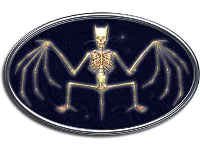 The Hollywood film “Batman Forever” had just been released and BYP had already discussed filming a caped crusader adventure. We wanted to go further with our next movie – Geriatric Park had no script to speak of, or plot. This time we wanted both. After the plot was agreed, Mark set about writing the screenplay. It was long… very long… but we liked it. After the success of Geriatric Park, it was not difficult to find volunteers. We wanted more special effects and plenty more gore. Since the Batman films had been imaginatively titled “Batman”, “Batman Returns” and Batman Forever” it only seemed appropriate to call our film “Batman Returns Forever” (BRF).
The Hollywood film “Batman Forever” had just been released and BYP had already discussed filming a caped crusader adventure. We wanted to go further with our next movie – Geriatric Park had no script to speak of, or plot. This time we wanted both. After the plot was agreed, Mark set about writing the screenplay. It was long… very long… but we liked it. After the success of Geriatric Park, it was not difficult to find volunteers. We wanted more special effects and plenty more gore. Since the Batman films had been imaginatively titled “Batman”, “Batman Returns” and Batman Forever” it only seemed appropriate to call our film “Batman Returns Forever” (BRF).
Filming began in July 1995. A schedule was drawn up to film over a 2-week period. This was the first time BYP had ever been so organised as to concentrate the filming over a limited period. It was hard work. Each of the filming days lasted over 12 working hours (often longer). Unlike Geriatric Park, we were now filming in Canterbury and Dover town centres, as well as the woods in Tilmanstone. We hired a village hall to build the bingo set and the laboratory, and we rented a van for Mouldy’s bus. We even used a local Air Training Corps building for the briefing room. The production was planned to the nth degree. With the exception of a few short clips, filming was complete by August and work began on the enormous task of editing and scoring. Editing was complicated and lengthy. We wanted stereo music and sound effects, but we also wanted to maintain visual quality.
After numerous overnight editing shifts and countless computer hard drive failures, the film was ready by mid December 1995, ready for the premiere on the 29th. BYP was going to spare no expense for this evening. A cinema was hired to show BRF to the invited audience. Many of the guests had seen Geriatric Park and had been eagerly waiting for our next feature. The lights fell once again and the film began. They laughed throughout, but slept also. BRF was too long and the gags too few. However the special effects and gore were spectacular enough for most to enjoy the movie. Ultimately BRF was a success, but lessons had been learned.
Backyard Productions sat back and thought hard about what was next on the agenda. We wanted to capture again the magic we had found with Geriatric Park, but with the professionalism of Batman Returns Forever.
In the meantime, STTNGG was moving forward in leaps and bounds. Well into its 4th season, we were now including songs and plots to each episode. The advent of MiniDisc also helped a great deal. It was decided around this time that the sound studio set up was such that it deserved to be known as a department in its’ own right. The “Backyard Productions Stereophonic Workshop” was officially created.
It had now been a while since we had completed any filming and we were keen to get back in front of, and behind the camera. Edwin suggested that we should try and come up with something much more original, right down to the music itself. After some deliberation, we came up with the idea of “Stairgate”, based on the film “Stargate”. This was as far as the similarities went. The characters, story, script and score would be entirely original. Plots were written and characters drawn. Mark worked hard to produce a complete score, with themes ranging from action to sad. Unfortunately there was no “magic” – none of us could see where the story was going and it seemed as if we were writing Stairgate for the sake of originality rather than because it was a good story. During the production of the 5th season of STTNGG, Stairgate finally fizzled out with no formal declaration of failure. Mark’s music has never been used.
As time moved on, STTNGG forged on with ever more complicated sound effects, hilarious plots and plenty of bad taste humour. With digital home video just around the corner, it was obvious that the technology was accelerating. We agreed that our editing restrictions meant we needed to invest in some new technology. We investigated a number of possible solutions, including Hi-8, DV and computer editing. It was all very expensive and we couldn’t justify spending a large amount of money, since BYP at that time realistically produced nothing more than humorous sketches. We settled on a more conventional means of editing, with twin video decks, monitors, a vision and sound mixer, and a new Hi-8 camcorder. We could now wipe or mix to new scenes and add stereo music!
In 1997 we put our newly acquired equipment to the test with a sketch entitled “Sad Boys”. The story was feeble and the swearing copious. But there were some great stunts and, as always, the final product proved entertaining. After filming, we set about editing and scoring. It was not long however, before we noticed that despite the improved format, the resulting picture still showed signs of video degradation. The format was good but not that good. Furthermore the editing process itself was still slow and complicated.
BYP completed a second Hi-8 format production – “Coronation Street”. This project combined filming on the actual set of the real street, with some clever blue screen work. Again the editing was just as clumsy as before and despite the time base correction facilities, the video quality was still not good enough. We needed to look elsewhere…
Again we investigated ways of improving the quality of our pictures. “Sad Boys 2” was produced to examine in depth wiping, mixing and voice over work. Whilst the sound quality was now near perfect, the video was still proving to be a problem. We agreed the multiple copying (a necessary part of the editing process), was the main cause of the problem.
For example, a scene is shot in Hi-8 format (1st generation). This is then edited to VHS and mono sound effects are added with the audio dub facility (2nd generation). The tape is copied again to a second VHS tape while adding the stereo soundtrack (3rd generation). This finished video is then copied for distribution, so the recipients receive a 4th generation copy. Having copied from the original 3 times, the visual quality is severely compromised. This was the problem. Even if we had a digital camera, a 4th generation copy would still be poor. We could not afford to buy a suite of digital video recorders, or even SVHS ones. We needed another solution.
By this time, Edwin had graduated from university and was now established in the paid environment of doctoring at the local hospital. With his new income, a digital camcorder was bought. Several tests were carried out, but the conclusion was the same, we still needed a new editing process. BYP now had digital sound and video, but not digital editing.
Just as digital camcorders had become more affordable, so did computer editing. Previously a computer fast enough to process real time, full screen video was far too expensive but now we could consider this option. Computers, of course, can do a lot more than just edit. We could create far more elaborate blue screen effects and full motion superimposition. Sound mixing would become easier – synchronising and resynchronising at the touch of a button. In July 1999 George Lucas finally released “Star Wars Episode I” in the UK. This, and the affordability of computer based, non-linear editing, prompted me to consider making a “Star Wars” spoof.
Finally we took the plunge and bought the computer. We had already begun work on the plot for a Star Wars film and decided the most spectacular effect we could generate was a lightsaber duel. We would test this out first. A fight was choreographed by Mark and I, and filmed one weekend. Mark then processed the 15 seconds of footage. A week later it was ready for screen testing. This time it was Mark’s turn to pour out the excuses about the limitations of the footage before it was shown, but we sat down and watched the 15-second fight… It was amazing! Mark and I were actually fighting with real lightsabers! There were noises and clashes and most importantly of all, the lightsabers glowed. The picture quality was perfect, as the computer had copied the video with no degradation. We had finally found the solution and Backyard Productions was ready to make a Star Wars movie…
Comments
3 Responses to “BYP 1984-1999”
Feel free to leave a comment...
and oh, if you want a pic to show with your comment, go get a gravatar!







Good Day Onan Bridgewater here,
I am very interested in doing some work with your company, please have a look at my some of my work and let me know if you may be able to use my talents:
Just a bit on who I am : I work for a company called DreamSoft – a Bahamas based production group that specializes in 3d animation, Visual effects and sprite base imagery. Approaching the last quarter of this year, I have been thinking about venturing into VFX (Visual effects) for music videos and independent films. I came across your site via ‘Red Inkworks’ and was very interested in your approach with your work; I am the same way.
Link to Gallery:
http://dreamsoft3d.50webs.com/gallery.html
You can go to the bottom of the page for the 3D stuff. Also on the ‘Home’ page is a short animation example (refresh the page if it does not play)
I am still updating the site, so there is more to come.I can do lots of VFX things like gun flashes, 2D/3D tracking and digital blood. Also feel free to ask any questions or express any concerns.
Best regards “I love the Doom Raider stuff”- O.B.
[…] Darren Scales, of Backyard Productions, has been making films for over 20 years. He said: “I was in the RAF and with any spare time […]
[…] Darren Scales, of Backyard Productions, has been making films for over 20 years. He said: “I was in the RAF and with any spare time […]